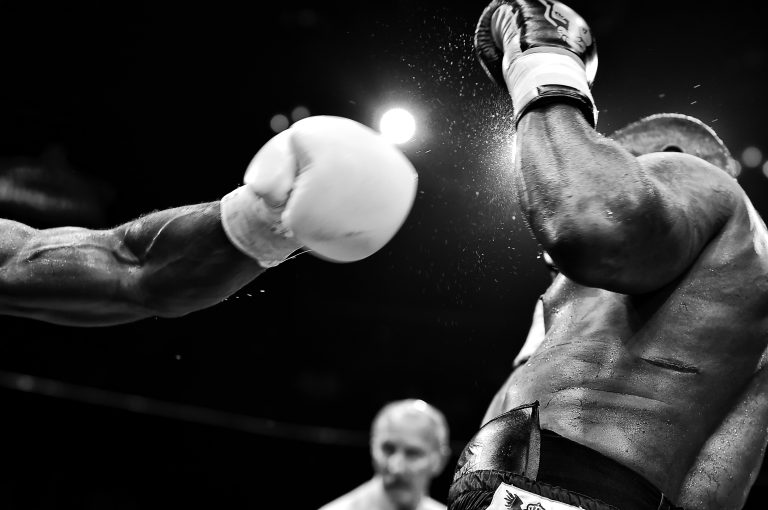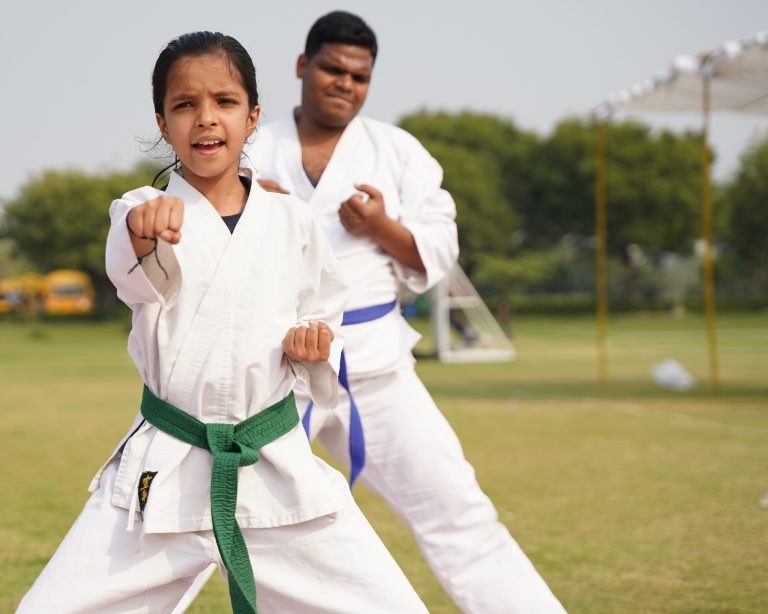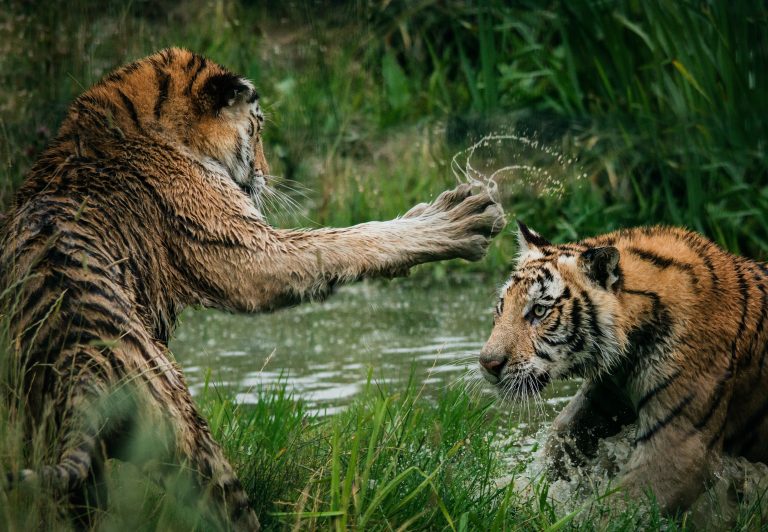Shotokan Karate Gürtelfarben in Reihenfolge
Shotokan-Karate ist eine Disziplin des Karate, die in Japan entwickelt wurde. Es ist eine Kampfsportart, die sich auf Techniken wie Tritte, Schläge und Stöße konzentriert. Eine bedeutende Rolle in dieser Kampfsportart spielen die Gürtel, die einen Fortschritt und eine erzielte Leistung symbolisieren.
Im Shotokan Karate gibt es insgesamt acht Gürtelfarben, die einen Aufstieg des Karatekas symbolisieren. Die Reihenfolge der Gürtelfarben in Shotokan Karate ist im Folgenden beschrieben:
Weißer Gürtel (9. Kyu)
Der weiße Gürtel steht für den Anfang eines jeden Karatekas. Ein Anfänger fängt immer bei diesem Gürtel an. Dieser Gürtel symbolisiert Unschuld und Unwissenheit über die Kampfkunst.
Gelber Gürtel (8. Kyu)
Der gelbe Gürtel steht für das erste Ziel, das ein Karateka erreichen kann. Der gelbe Gürtel symbolisiert das Wissen, das man durch das Erlernen der Techniken erlangt hat. Der Karateka muss eine bestimmte Anzahl von Techniken lernen und beherrschen, um diesen Gürtel zu bekommen.
Orangener Gürtel (7. Kyu)
Der orangene Gürtel repräsentiert die aufkommende Sonne und symbolisiert den Beginn eines neuen Tages. Der Karateka muss eine gewisse Anzahl von Techniken und Kata (Kampfsequenzen) lernen und beherrschen, um diesen Gürtel zu bekommen.
Grüner Gürtel (6. Kyu)
Der grüne Gürtel steht für Wachstum und symbolisiert das Wissen, das dein Karateka bereits erlangt hat. Der Karateka muss vor allem die Kihon-Kata (Grundübungen und Anfängerform) beherrschen.
Blaue Gürtel (5. Kyu)
Der blaue Gürtel symbolisiert den Himmel und den Versuch, die Grenzen der Technik zu erweitern. Der Karateka muss neue Techniken und Kata erlernen, um diese Prüfung zu bestehen.
Brauner Gürtel (4. Kyu bis 1. Kyu)
Der braune Gürtel repräsentiert die Tiefe und das Wissen, das der Karateka im Laufe der Zeit erlangt hat. In Shotokan Karate gibt es insgesamt drei Stufen (3.Kyu, 2. Kyu und 1.Kyu) mit dem braunen Gürtel. Um diese Stufen zu erreichen, müssen die Karateka komplexere Techniken, Kata und Grundlagenprogramme beherrschen.
Schwarzer Gürtel (1.Dan bis 10. Dan)
Der schwarze Gürtel ist das ultimative Ziel eines jeden Karatekas. Es gibt insgesamt zehn Stufen (Dan) im Karate, die mit dem schwarzen Gürtel verbunden sind. Um diesen Gürtel zu erreichen, müssen die Prüflinge alle Techniken, Kata und das Wissen, das sie bisher erworben haben, zeigen und beherrschen.
Insgesamt symbolisieren die Gürtelfarben des Shotokan Karate verschiedene Stufen, die ein Karateka während seines Kurses erreichen kann. Es ist nicht nur die Frage des Könnens, sondern auch ein Zeichen des Stolzes und der Hingabe an diese Kampfkunst.
Shotokan Karate Gürtelfarben in Reihenfolge
Shotokan Karate is a martial art that originated in Japan in the 1930s. Like all martial arts, Shotokan Karate has a belt system that is used to indicate a student’s progress and rank within the art. In this blog post, we will discuss the most frequently asked questions about the Shotokan Karate belt system and the order of color belts.
What is the Shotokan Karate Belt System?
The Shotokan Karate belt system is a system of ranking that is used to indicate a student’s progress in the art. A student’s rank is indicated by the color of their belt. As students progress through the ranks, they are required to learn new techniques and demonstrate their proficiency in those techniques.
What are the Belt Colors in Shotokan Karate?
The Shotokan Karate belt system starts with a white belt and progresses through several colors, including yellow, orange, green, blue, brown, and black. Each color represents a certain level of proficiency and mastery in the art.
What is the Order of the Belt Colors in Shotokan Karate?
The order of the Shotokan Karate belt colors is as follows:
1. White Belt – The white belt is the starting point for all students in Shotokan Karate.
2. Yellow Belt – The yellow belt is the first color belt in Shotokan Karate and represents that the student has learned the basics of the art.
3. Orange Belt – The orange belt represents that the student has progressed beyond the basics and is starting to master more advanced techniques.
4. Green Belt – The green belt indicates that the student has reached an intermediate level of proficiency in the art.
5. Blue Belt – The blue belt represents that the student is progressing towards becoming an advanced student in Shotokan Karate.
6. Brown Belt – The brown belt represents that the student has mastered the basics of the art and is starting to specialize in certain areas.
7. Black Belt – The black belt is the highest rank in Shotokan Karate and represents mastery of the art.
How Long Does it Take to Get a Black Belt in Shotokan Karate?
The time it takes to get a black belt in Shotokan Karate varies from student to student. Generally, it takes several years of dedicated practice to reach the black belt level. Some schools have minimum training times or age requirements for students to be eligible to test for black belt.
How are Belt Promotions Determined in Shotokan Karate?
Belt promotions in Shotokan Karate are generally determined by a combination of factors, including:
1. Attendance – Regular attendance to classes is important for progress in the art.
2. Skill Level – Students must demonstrate proficiency in the techniques required for their current rank.
3. Time – There is a minimum time requirement for students to be eligible to test for the next rank.
4. Attitude – Students must display a positive attitude and respect towards their instructors and fellow students.
5. Competition – Some schools may require students to compete in tournaments or demonstrate their skills in front of a panel of judges to be eligible for promotion.
What Should I Expect from a Belt Test in Shotokan Karate?
Belt tests in Shotokan Karate generally involve demonstrating proficiency in the techniques required for the student’s current rank. Tests may also include a written examination and a demonstration of kata, which is a sequence of martial arts techniques performed in a specific order. The test is usually conducted in front of a panel of judges or the student’s instructors.
Conclusion
Shotokan Karate is an art that emphasizes self-discipline, respect, and physical fitness. The belt system is an important part of the art, as it helps students track their progress and set goals for themselves. By understanding the order of belt colors and the requirements for each rank, students can work towards achieving their goals and becoming proficient in the art of Shotokan Karate.
Inhaltsverzeichnis






